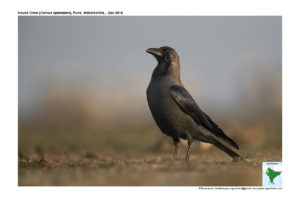House Crow

House Crow Corvus splendens
Etymology:
- Corvus : Latin word for Raven
- Splendens : Latin word for Brilliant , Glittering
Vernacular Names: Sind: Kan, Hindi: Kowwa, Desi kowwa, Sans: Gram kak, Kash: Kav, Pun: Kan, Ben: Kag, kak, Ass: Paati kaori, Guj: Kagdo, Nano kagdo, Mar: Kavla, Ori: Kujikau, Ta: Nalla kaka, Maniyan kakai, Oor kagam, Te: Manchi kaki, Kaki, Mal: Kakka, Kan: Kaage, Sinh: Kaputa, Kolamba kaka, Mald: Karlu
Distribution in India: Widespread Resident throughout the country
Description: Size of 39-40 cm Wt. of 245-370 g. It is a relatively small, rather slim-bodied, somewhat “leggy” crow with comparatively long, prominent, slightly arched bill enhanced by short “pinched” forecrown. The nominate race is mostly blackish-slate, blacker and more glossed on face, forecrown, chin and throat; nape to mantle, side of neck and side of breast are medium-grey, shading into blackish-grey on lower underparts, and glossy blackish on back, rump and uppertail-coverts. The upperwing and tail are glossy black; iris is dark brown; bill and legs are black. Both the sexes are similar. The juvenile is similar to adult but duller, without gloss on black parts of plumage. The races differ mainly in colour saturation. The race zugmayeri is palest, with nape almost whitish-grey; race protegatus is much darker, with less contrast between nape and body
Habitat: It is found abundant about human habitation of all types, from city-center parks to railway stations, sprawling slums and coastal villages. Chiefly a lowland species, but has spread into several hill stations in Himalayas, mainly below 1600
Food Habits: It’s an Omnivores scavenger. Rarely Hunts. Lives on scraps from Human settlements and shops like Butcher shop, hotels etc. Community feeder, can form large flocks to eat.
Breeding Habits: They breed in April-July. It is monogamous, with long-term pair-bond, but many individuals are somewhat promiscuous. Solitary nester. Both sexes collect nest material, but normally only female builds, an untidy stick nest generally lined with soft materials .The stick frame often augmented with metal and wire from human settlements. Nest is placed high in fork of large tree, like banyan or mango and also on ledges on buildings, electricity poles and streetlamps. Lays a clutch of average 4 eggs; incubation by female alone for a period of 16–17 days; chicks fed by both parents, nestling period 21–28 days. Nests parasitized by Common Koel.